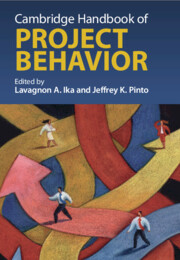Book contents
- Cambridge Handbook of Project Behavior
- Cambridge Handbook of Project Behavior
- Copyright page
- Contents
- Figures
- Tables
- Contributors
- Introduction
- Part I Guiding Principles
- Chapter 1 The Rise and Fall of the Planning Fallacy
- Chapter 2 Unveiling the Hiding Hand
- Chapter 3 Voyages of Discovery
- Chapter 4 Temporal Structuring and Project Behavior
- Chapter 5 Managing Project Complexity and Uncertainty through Dynamic and Systemic Stakeholder Modeling
- Part II Deviating from Plans
- Part III Practical Tips
- Index
- References
Chapter 2 - Unveiling the Hiding Hand
from Part I - Guiding Principles
Published online by Cambridge University Press: aN Invalid Date NaN
- Cambridge Handbook of Project Behavior
- Cambridge Handbook of Project Behavior
- Copyright page
- Contents
- Figures
- Tables
- Contributors
- Introduction
- Part I Guiding Principles
- Chapter 1 The Rise and Fall of the Planning Fallacy
- Chapter 2 Unveiling the Hiding Hand
- Chapter 3 Voyages of Discovery
- Chapter 4 Temporal Structuring and Project Behavior
- Chapter 5 Managing Project Complexity and Uncertainty through Dynamic and Systemic Stakeholder Modeling
- Part II Deviating from Plans
- Part III Practical Tips
- Index
- References
Summary
The ‘Hiding Hand’ is a metaphor which Albert Hirschman used, to characterise the international development process. It states that international development projects typically incur major cost overruns and other implementation problems, which put in question the decision to launch them in the first place. Indeed, had these difficulties been known in advance, the projects might never have been even tried. Nevertheless, human ingenuity often finds a way around these difficulties and can indeed discover unforeseen benefits, which may then justify the project after all.
This has come in for strong criticism, by writers such as Flyvbjerg, based on his own analysis of projects, their costs and their effects. Flyvbjerg however has ‘tested’ the Hiding Hand at only a very limited micro level of the individual project. He misses Hirschman’s account of the larger environment within which international development projects and the Hiding Hand operate.
Part 3 addresses that macro-context, as viewed by Hirschman; from there it then turns back to the individual project and its evaluation. Part 4 situates the Hiding Hand in relation to larger debates on economic and political development. Part 5 considers the responsibility of social scientists, to hold development actors and the political community to account.
Information
- Type
- Chapter
- Information
- Cambridge Handbook of Project Behavior , pp. 46 - 57Publisher: Cambridge University PressPrint publication year: 2025
References
Accessibility standard: WCAG 2.0 A
Why this information is here
This section outlines the accessibility features of this content - including support for screen readers, full keyboard navigation and high-contrast display options. This may not be relevant for you.Accessibility Information
Content Navigation
Allows you to navigate directly to chapters, sections, or non‐text items through a linked table of contents, reducing the need for extensive scrolling.
Provides an interactive index, letting you go straight to where a term or subject appears in the text without manual searching.
Reading Order & Textual Equivalents
You will encounter all content (including footnotes, captions, etc.) in a clear, sequential flow, making it easier to follow with assistive tools like screen readers.
You get concise descriptions (for images, charts, or media clips), ensuring you do not miss crucial information when visual or audio elements are not accessible.
You get more than just short alt text: you have comprehensive text equivalents, transcripts, captions, or audio descriptions for substantial non‐text content, which is especially helpful for complex visuals or multimedia.
You can access graphs or charts in a text or tabular format, so you are not excluded if you cannot process visual displays.
Visual Accessibility
You will still understand key ideas or prompts without relying solely on colour, which is especially helpful if you have colour vision deficiencies.
You benefit from high‐contrast text, which improves legibility if you have low vision or if you are reading in less‐than‐ideal lighting conditions.
